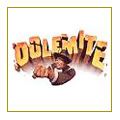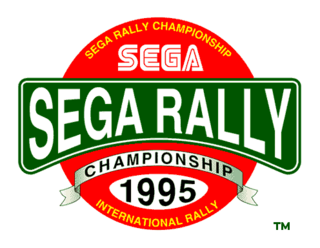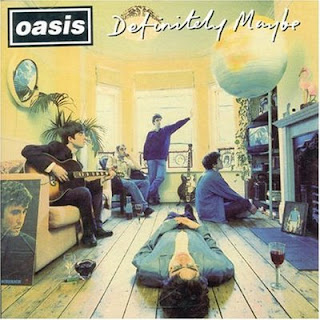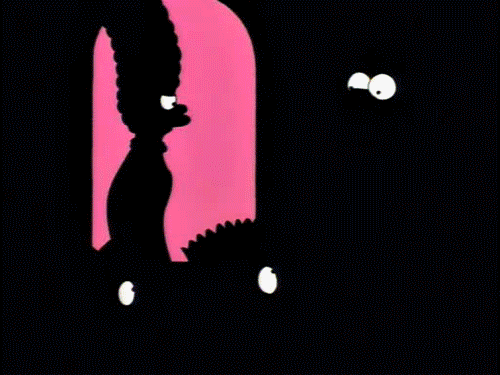Post by Deleted on May 4, 2012 22:17:32 GMT
I thoroughly enjoyed reminiscing over these. I love the artwork he used for the band, he really did capture the spirit of the track/album in most of them. Just a bit of a pity there's no word about Stand By Me and The Masterplan. Oh, and I never knew that reason behind Roll With It being robbed of reaching number one. Cannon4it.
Supersonic

The shot was taken at Monnow Valley studios in Wales where they had started recording Definitely Maybe. The idea was to have a cluttered studio environment with amps and cables strewn everywhere. Liam was only 21 at the time and already looked like a fully formed rock star so I decided to have him at the front of the shot.
I thought it would be a nice twist if I had my tungsten lights in view, the idea being to put Oasis firmly in the ‘spotlight’ for their debut single. I cross-processed the film which gives the shot its bluey tint.
Shakermaker
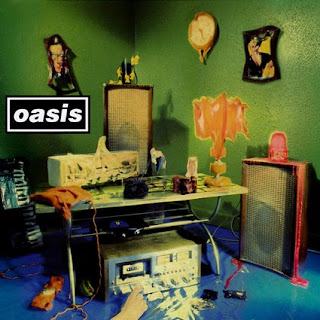
The cover was a dali-esque type concept. I’ve always really been into the surrealists such as Magritte and Dali and I liked the idea that hard objects can take the form of soft ones. The idea was that if you played Oasis music loud enough the contents of your room would melt.
The shot was taken in the corner of my apartment in Manchester which had become an improvised studio. I went around all the junk shops in Manchester buying various plastic objects which I then melted on my front porch with an industrial blow torch not too dissimilar from a World War 2 flame thrower! It was really funny seeing the reaction of my neighbours, they just couldn’t figure out what was going off.
Live Forever

When it came to do the photography for Live Forever nobody had any ideas on what was to go on the cover. My first thoughts were that it should feature a scene from everyday life; people walking in a street, or a group of people standing at a bus shelter in the rain maybe; something ordinary. This process of ‘writers block’ went on for several weeks until the band asked me if I had anything in my archive which would be appropriate.
I remembered a photograph that I'd taken a few years earlier of John Lennon’s childhood home in Liverpool that had an ethereal and mysterious quality. The photograph seemed to work on two levels: firstly it was a picture of an ordinary suburban semi which reflected some of the song's lyrical content and secondly when you considered that the greatest artist of the 20th century had grown up in the house the picture took on a far more powerful quality. Noel loved the picture and the sentiment behind it as soon as he saw it. So in many ways it was one of the easiest covers I worked on because the picture had already been taken.
Definitely Maybe
.jpg)
The initial idea for Definitely Maybe came from the back cover to A Collection of Beatles Oldies which was a group photograph of The Beatles gathered round a small table in a Japanese hotel room. Oasis had decided that a similar group photograph should be taken in Bonehead’s front living room. I’d already heard the album many times and knew that it was a great challenge to create an image suitable for the cover. I was therefore horrified when I went to recce the room and saw how small and uninspiring the room was.
The band had assumed that I would take the photograph looking into the room with the bay window as a source of illumination – in other words the opposite direction to how it finally appeared on the cover. To me the bay window was the most interesting feature of the room and so I decided to take the unusual step of shooting into the light of the bay window. I then lit the room accordingly to avoid the band appearing as silhouettes.
The size of the room was made to look bigger by using a wide angle lens but this created a problem with the floor. The stripped flooring (which I believe Bonehead had done himself) had been transformed into this huge ‘desert’ expanse which overwhelmed and dominated the shot. The empty space and what to do with it became a real problem. A week before the shoot I had visited the Egyptology section at The Manchester Science Museum and as a result, the whole notion of lying in a preserved state and the way the Egyptians honoured and represented their past kings was very much fresh in my mind. The idea then occurred to me to have Liam lying outstretched and motionless on the floor with his head towards the camera and with his eyes closed; a rock icon ‘lying in a state’ or indeed some other transcendental state but not of this world.
This would create a first for an album cover but more importantly would solve my problem of what to do with the empty space and the stripped flooring. On the face of it asking the lead singer to adopt this pose for his debut album cover was a bizarre request and so I was relieved when Liam agreed to do it. I know many other singers who would have refused. This along with the spinning globe was the catalyst to the whole shot. Definitely Maybe has to be one of the best covers I did for Oasis and I know the band themselves were really pleased with it.
Cigarettes & Alcohol

I shot the sleeve to Cigarettes & Alcohol at the Halcyon Hotel in TCOTU which was a favourite haunt of actors and musicians. The band had just returned from a controversial visit to Sweden where they had been given a ‘free lift’ back to the airport by the Swedish authorities after a number of reported incidents. When they arrived at the hotel they were in very high spirits.
The idea was basically to do a rock’n’roll type scene which mirrored the elements in the song. It was a great and memorable evening; Noel did an impromptu acoustic set for those of us still left in the room in the early hours. There were numerous complaints from the other residents and a four figure room service bill! Tim Abbott is the guy at the front of the shot who had been one of the directors at Creation Records. I shot it on fast grainy b/w film and later hand toned the image blue.
Whatever

The original plan was to shoot the sleeve in the vast open spaces of the Arizona desert. Noel had wanted a vast landscape to evoke a sense of freedom. It was a very simple brief and was to be a relatively straight forward shot. I flew out to the states to photograph the band but after only a few days in Los Angeles the band had the infamous fall-out at the Whisky-a -go-go and Noel disappeared.
At the time it was very serious because the US tour had to be called off and for a while Noel was on the missing persons list. I went back to the UK feeling really disappointed but after two weeks news came through that Oasis had patched things up and the release was still to go ahead. Noel suggested doing the shot in Salisbury Plain but in the end I took the photograph on the Derbyshire moors close to where I had grown up in Sheffield.
Some Might Say

This shot was basically a visual interpretation of the lyrics. Noel had wanted to have the photograph set at a working train station but I thought it would make for a more interesting and surreal shot if the station was disused with a set of characters waiting for a train that would never arrive.
The platform could act as the stage. I must have spent 2 weeks reccying the shot all around England, in the end a neighbour who I had been chatting to about the shot suggested Cromford station near Matlock in Derbyshire. I checked it out and it was the ideal location. I shot it on black and white film and spent a week or so hand painting the photograph with watercolours and a brush to create more of a surrealist effect.
Roll With It

The original idea came from a dream that Noel had where he saw hundreds of TV’s floating down a river. This idea developed to TV’s in the sea and then TV’s on the beach. As Alan White, their new drummer, had just joined the band it was decided the cover would be a band shot so it became the band watching TV’s on the beach. They had wanted to wear Duffel coats which I thought was a nice visual pun and very much Oasis.
The shot which I wanted on the cover was the one that went onto the CD disc itself which in my opinion was a far better shot than the one that appeared on the sleeve. In the end record company messed up with the barcodes and initial sales were not registered thus affecting its chart position, furthermore and quite astonishingly, a batch of CD’s were pressed and distributed with the wrong music on! The pressing plant had put some obscure reggae artist onto the Oasis CD by mistake and so instead of hearing ‘Roll With It’ you heard African reggae music.
I can remember playing my copy and thinking ‘hang about, this doesn’t sound like Oasis’. I’m not quite sure how many copies were pressed like this but I’m sure they’re now highly collectable.
(What’s The Story) Morning Glory?

Noel had described the recent music Oasis had been recording as riot music, and so that was taken as a green light to develop concepts about rioting and anarchy. So early on in the creative process there were one or two discussions about a Molotov cocktail featuring in some way on the cover, however that theme was quickly shelved when we heard tracks like Wonderwall and Cast No Shadow.
After many meetings about the artwork and what was to feature on the cover, it was finally agreed that we would have an early morning street scene with two men walking towards each other. I wanted the shot to be ambiguous and without any moral perspective. Unlike film, the power of the still image comes from its inherent weakness to portray the truth or to tell a narrative; we don’t know if the characters know each other, whether they are good or bad, friendly or hostile, whether they are going to stop and talk to each other or who they are?
It’s a brief narrative rooted in a very ambiguous moment and is for those reasons one of my favourite Oasis covers.
Wonderwall
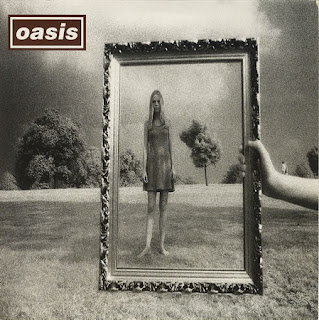
I had originally shot Liam for the front cover of Wonderwall in Primrose Hill, TCOTU but Noel had accidentally stumbled across us doing the shoot on his way to Creation Records. I can remember a bloke jumping out of a black cab and yelling at us through the railings of the park. I thought it was an Oasis fan heckling us so I ignored all the shouting and continued with the shoot.
The shouting continued so I finally decided to go and tell this bloke to leave us alone and then realized to my astonishment that the bloke was in fact Noel Gallagher. He explained that Wonderwall was ‘a f**king love song!’ and that no way was ‘our kid’ appearing on the cover. The shoot was quickly aborted and in the end I re-shot it the following day with a girl from Creation Records called Anita Heyert. I used the same black and white infra-red effect on this cover as I did on Live Forever.
Don’t Look Back In Anger
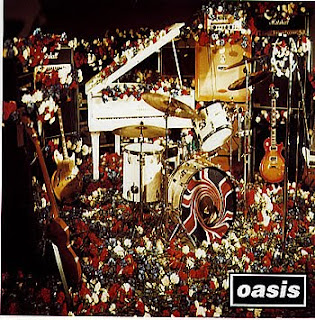
For the cover of Don’t Look Back In Anger Noel had decided to pay homage to an incident which had happened at Abbey Road studios in 1968. It was inspired by a story about Ringo Starr walking out on the Beatles because he felt that he was not wanted. He was eventually persuaded to come back into the band and on his return George Martin, the Beatles producer, had decided to deck his entire drum kit out in flowers as a statement of love and gratitude. Noel thought this sentiment would make an interesting idea for a cover and so suggested we had the bands equipment covered in thousands of red, white and blue flowers, the colours of the Union Jack.
It was originally going to be an overhead shot and I had a scaffolding tower erected but I then decided to shoot it at eye level so that the bass drum with its Union Jack swirl could feature more prominently in the shot. The white piano was a reference to John Lennon. I had Creation Records import 5,000 carnations, of those 3,500 were white and of those 3,500, half were dyed blue as blue carnations do not grow naturally. A real privilege to have done this cover as it is one of the greatest pop songs ever.
D’You Know What I Mean?
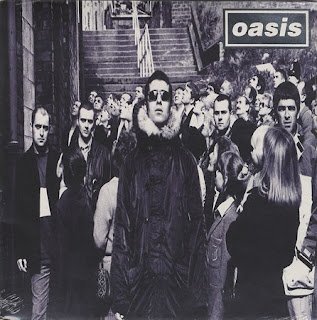
I shot the cover to D’you Know What I Mean? in an alleyway in Wigan, Lancashire next to a boxing club. An extremely difficult shoot to execute simply because of the number of people involved. Initially there was no shape to the photograph, and the band melted into the crowd and almost became invisible. The light was also very poor which did not help matters.
The photograph eventually came together when I positioned a young woman holding her baby alongside a girl in her school blazer in front of the band. This seemed to give the shot the extra depth and shape it needed. The sun briefly came out and I knew this would be the shot that would end up on the cover. The single, although not political, was released just prior to the 1997 general election. After 18 years of Conservative government there was definitely a sense that this was a rallying call for change. It certainly went through my mind when I was taking the shot. It turned out to be one of my favourite photographs of the band.
Be Here Now

Originally the cover was to feature 4 separate photos each with a separate band member. To overcome the mathematical problem that there were five people in the band Liam would have a cameo presence in all of the shots. Noel wanted to be photographed up a tree playing guitar, Alan White in some east end pub, Guigsy on a beach in St. Lucia and Bonehead wanted to be photographed relaxing by a swimming pool at night with a rolls Royce submerged in it as an homage to Keith Moon. However, concerns grew that 4 separate images on a CD cover would have little impact and the idea was dropped.
All was not lost as it became apparent that of all the ideas put forward by the band Bonehead’s idea of a Rolls Royce in a swimming pool was by far the best. Many locations were considered including Clivedon where the Profumo scandal of the 1960’s had taken place. Eventually Stocks Hotel in Hertfordshire, the former home to the Playboy magnate, Victor Lowness was chosen as it had a swimming pool directly in front of the house. The shoot was fraught with difficulties. Firstly, Stocks Hotel was a hotel open to the public and as word got out the hotel came under siege. Secondly far too much alcohol was consumed on set and so by evening time the shoot had become chaotic, also one of the generators blew. In the end a shot from the daytime session was chosen although the shots I took at the night-time session are very interesting.
All Around The World
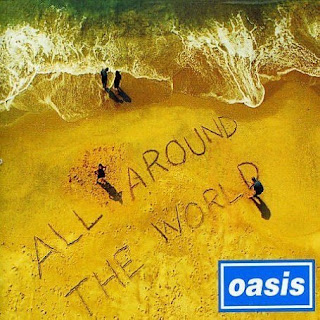
With any conceptual photograph there is always an initial idea or trigger which forms the basis for the inspiration. With All Around The World the initial inspiration came from a photograph taken from the top of a beach side hotel in Florida where Beatles fans had communicated with their idols above by writing messages to them in the sand.
To write the song title in the sand was an obvious development for the cover, it also fitted in with the global sentiment of the song. People have been writing messages in the sand for centuries and so for me I saw the beach as a global messaging board or forum where anybody could come along and post a message, in retrospect like a Stone Age version of twitter.
However, conceptual ideas don’t always work visually and the problem with this shot was that there was nothing of substance to give the photograph depth or shape. At this point I decided that it was vital to have the sea featured in some way in the shot. It would also add to the notion that the message was transitory and that at some point the message would be washed away by an incoming wave. In the end it was myself who wrote the message in the sand by using a stick.
The positioning was vital, too close to the sea and the sea would wash it away and too far away and it would not be possible to have both the message and the sea in shot at the same time. I took the shot from the top of an extended hydraulic arm attached to a fire engine which was in a fixed position on the beach front (in Bournemouth, England). There was only one stretch of beach so the positioning of the lettering had to be right first time. It would not be possible to rub it out and start again as this would have disturbed the appearance of the sand.
When I was taking the picture I was struck by the way the sea entered the frame at the top of the picture, this was very reminiscent of beer overflowing down the side of a glass and this to me makes the shot.
Supersonic

The shot was taken at Monnow Valley studios in Wales where they had started recording Definitely Maybe. The idea was to have a cluttered studio environment with amps and cables strewn everywhere. Liam was only 21 at the time and already looked like a fully formed rock star so I decided to have him at the front of the shot.
I thought it would be a nice twist if I had my tungsten lights in view, the idea being to put Oasis firmly in the ‘spotlight’ for their debut single. I cross-processed the film which gives the shot its bluey tint.
Shakermaker

The cover was a dali-esque type concept. I’ve always really been into the surrealists such as Magritte and Dali and I liked the idea that hard objects can take the form of soft ones. The idea was that if you played Oasis music loud enough the contents of your room would melt.
The shot was taken in the corner of my apartment in Manchester which had become an improvised studio. I went around all the junk shops in Manchester buying various plastic objects which I then melted on my front porch with an industrial blow torch not too dissimilar from a World War 2 flame thrower! It was really funny seeing the reaction of my neighbours, they just couldn’t figure out what was going off.
Live Forever

When it came to do the photography for Live Forever nobody had any ideas on what was to go on the cover. My first thoughts were that it should feature a scene from everyday life; people walking in a street, or a group of people standing at a bus shelter in the rain maybe; something ordinary. This process of ‘writers block’ went on for several weeks until the band asked me if I had anything in my archive which would be appropriate.
I remembered a photograph that I'd taken a few years earlier of John Lennon’s childhood home in Liverpool that had an ethereal and mysterious quality. The photograph seemed to work on two levels: firstly it was a picture of an ordinary suburban semi which reflected some of the song's lyrical content and secondly when you considered that the greatest artist of the 20th century had grown up in the house the picture took on a far more powerful quality. Noel loved the picture and the sentiment behind it as soon as he saw it. So in many ways it was one of the easiest covers I worked on because the picture had already been taken.
Definitely Maybe
.jpg)
The initial idea for Definitely Maybe came from the back cover to A Collection of Beatles Oldies which was a group photograph of The Beatles gathered round a small table in a Japanese hotel room. Oasis had decided that a similar group photograph should be taken in Bonehead’s front living room. I’d already heard the album many times and knew that it was a great challenge to create an image suitable for the cover. I was therefore horrified when I went to recce the room and saw how small and uninspiring the room was.
The band had assumed that I would take the photograph looking into the room with the bay window as a source of illumination – in other words the opposite direction to how it finally appeared on the cover. To me the bay window was the most interesting feature of the room and so I decided to take the unusual step of shooting into the light of the bay window. I then lit the room accordingly to avoid the band appearing as silhouettes.
The size of the room was made to look bigger by using a wide angle lens but this created a problem with the floor. The stripped flooring (which I believe Bonehead had done himself) had been transformed into this huge ‘desert’ expanse which overwhelmed and dominated the shot. The empty space and what to do with it became a real problem. A week before the shoot I had visited the Egyptology section at The Manchester Science Museum and as a result, the whole notion of lying in a preserved state and the way the Egyptians honoured and represented their past kings was very much fresh in my mind. The idea then occurred to me to have Liam lying outstretched and motionless on the floor with his head towards the camera and with his eyes closed; a rock icon ‘lying in a state’ or indeed some other transcendental state but not of this world.
This would create a first for an album cover but more importantly would solve my problem of what to do with the empty space and the stripped flooring. On the face of it asking the lead singer to adopt this pose for his debut album cover was a bizarre request and so I was relieved when Liam agreed to do it. I know many other singers who would have refused. This along with the spinning globe was the catalyst to the whole shot. Definitely Maybe has to be one of the best covers I did for Oasis and I know the band themselves were really pleased with it.
Cigarettes & Alcohol

I shot the sleeve to Cigarettes & Alcohol at the Halcyon Hotel in TCOTU which was a favourite haunt of actors and musicians. The band had just returned from a controversial visit to Sweden where they had been given a ‘free lift’ back to the airport by the Swedish authorities after a number of reported incidents. When they arrived at the hotel they were in very high spirits.
The idea was basically to do a rock’n’roll type scene which mirrored the elements in the song. It was a great and memorable evening; Noel did an impromptu acoustic set for those of us still left in the room in the early hours. There were numerous complaints from the other residents and a four figure room service bill! Tim Abbott is the guy at the front of the shot who had been one of the directors at Creation Records. I shot it on fast grainy b/w film and later hand toned the image blue.
Whatever

The original plan was to shoot the sleeve in the vast open spaces of the Arizona desert. Noel had wanted a vast landscape to evoke a sense of freedom. It was a very simple brief and was to be a relatively straight forward shot. I flew out to the states to photograph the band but after only a few days in Los Angeles the band had the infamous fall-out at the Whisky-a -go-go and Noel disappeared.
At the time it was very serious because the US tour had to be called off and for a while Noel was on the missing persons list. I went back to the UK feeling really disappointed but after two weeks news came through that Oasis had patched things up and the release was still to go ahead. Noel suggested doing the shot in Salisbury Plain but in the end I took the photograph on the Derbyshire moors close to where I had grown up in Sheffield.
Some Might Say

This shot was basically a visual interpretation of the lyrics. Noel had wanted to have the photograph set at a working train station but I thought it would make for a more interesting and surreal shot if the station was disused with a set of characters waiting for a train that would never arrive.
The platform could act as the stage. I must have spent 2 weeks reccying the shot all around England, in the end a neighbour who I had been chatting to about the shot suggested Cromford station near Matlock in Derbyshire. I checked it out and it was the ideal location. I shot it on black and white film and spent a week or so hand painting the photograph with watercolours and a brush to create more of a surrealist effect.
Roll With It

The original idea came from a dream that Noel had where he saw hundreds of TV’s floating down a river. This idea developed to TV’s in the sea and then TV’s on the beach. As Alan White, their new drummer, had just joined the band it was decided the cover would be a band shot so it became the band watching TV’s on the beach. They had wanted to wear Duffel coats which I thought was a nice visual pun and very much Oasis.
The shot which I wanted on the cover was the one that went onto the CD disc itself which in my opinion was a far better shot than the one that appeared on the sleeve. In the end record company messed up with the barcodes and initial sales were not registered thus affecting its chart position, furthermore and quite astonishingly, a batch of CD’s were pressed and distributed with the wrong music on! The pressing plant had put some obscure reggae artist onto the Oasis CD by mistake and so instead of hearing ‘Roll With It’ you heard African reggae music.
I can remember playing my copy and thinking ‘hang about, this doesn’t sound like Oasis’. I’m not quite sure how many copies were pressed like this but I’m sure they’re now highly collectable.
(What’s The Story) Morning Glory?

Noel had described the recent music Oasis had been recording as riot music, and so that was taken as a green light to develop concepts about rioting and anarchy. So early on in the creative process there were one or two discussions about a Molotov cocktail featuring in some way on the cover, however that theme was quickly shelved when we heard tracks like Wonderwall and Cast No Shadow.
After many meetings about the artwork and what was to feature on the cover, it was finally agreed that we would have an early morning street scene with two men walking towards each other. I wanted the shot to be ambiguous and without any moral perspective. Unlike film, the power of the still image comes from its inherent weakness to portray the truth or to tell a narrative; we don’t know if the characters know each other, whether they are good or bad, friendly or hostile, whether they are going to stop and talk to each other or who they are?
It’s a brief narrative rooted in a very ambiguous moment and is for those reasons one of my favourite Oasis covers.
Wonderwall

I had originally shot Liam for the front cover of Wonderwall in Primrose Hill, TCOTU but Noel had accidentally stumbled across us doing the shoot on his way to Creation Records. I can remember a bloke jumping out of a black cab and yelling at us through the railings of the park. I thought it was an Oasis fan heckling us so I ignored all the shouting and continued with the shoot.
The shouting continued so I finally decided to go and tell this bloke to leave us alone and then realized to my astonishment that the bloke was in fact Noel Gallagher. He explained that Wonderwall was ‘a f**king love song!’ and that no way was ‘our kid’ appearing on the cover. The shoot was quickly aborted and in the end I re-shot it the following day with a girl from Creation Records called Anita Heyert. I used the same black and white infra-red effect on this cover as I did on Live Forever.
Don’t Look Back In Anger

For the cover of Don’t Look Back In Anger Noel had decided to pay homage to an incident which had happened at Abbey Road studios in 1968. It was inspired by a story about Ringo Starr walking out on the Beatles because he felt that he was not wanted. He was eventually persuaded to come back into the band and on his return George Martin, the Beatles producer, had decided to deck his entire drum kit out in flowers as a statement of love and gratitude. Noel thought this sentiment would make an interesting idea for a cover and so suggested we had the bands equipment covered in thousands of red, white and blue flowers, the colours of the Union Jack.
It was originally going to be an overhead shot and I had a scaffolding tower erected but I then decided to shoot it at eye level so that the bass drum with its Union Jack swirl could feature more prominently in the shot. The white piano was a reference to John Lennon. I had Creation Records import 5,000 carnations, of those 3,500 were white and of those 3,500, half were dyed blue as blue carnations do not grow naturally. A real privilege to have done this cover as it is one of the greatest pop songs ever.
D’You Know What I Mean?

I shot the cover to D’you Know What I Mean? in an alleyway in Wigan, Lancashire next to a boxing club. An extremely difficult shoot to execute simply because of the number of people involved. Initially there was no shape to the photograph, and the band melted into the crowd and almost became invisible. The light was also very poor which did not help matters.
The photograph eventually came together when I positioned a young woman holding her baby alongside a girl in her school blazer in front of the band. This seemed to give the shot the extra depth and shape it needed. The sun briefly came out and I knew this would be the shot that would end up on the cover. The single, although not political, was released just prior to the 1997 general election. After 18 years of Conservative government there was definitely a sense that this was a rallying call for change. It certainly went through my mind when I was taking the shot. It turned out to be one of my favourite photographs of the band.
Be Here Now

Originally the cover was to feature 4 separate photos each with a separate band member. To overcome the mathematical problem that there were five people in the band Liam would have a cameo presence in all of the shots. Noel wanted to be photographed up a tree playing guitar, Alan White in some east end pub, Guigsy on a beach in St. Lucia and Bonehead wanted to be photographed relaxing by a swimming pool at night with a rolls Royce submerged in it as an homage to Keith Moon. However, concerns grew that 4 separate images on a CD cover would have little impact and the idea was dropped.
All was not lost as it became apparent that of all the ideas put forward by the band Bonehead’s idea of a Rolls Royce in a swimming pool was by far the best. Many locations were considered including Clivedon where the Profumo scandal of the 1960’s had taken place. Eventually Stocks Hotel in Hertfordshire, the former home to the Playboy magnate, Victor Lowness was chosen as it had a swimming pool directly in front of the house. The shoot was fraught with difficulties. Firstly, Stocks Hotel was a hotel open to the public and as word got out the hotel came under siege. Secondly far too much alcohol was consumed on set and so by evening time the shoot had become chaotic, also one of the generators blew. In the end a shot from the daytime session was chosen although the shots I took at the night-time session are very interesting.
All Around The World

With any conceptual photograph there is always an initial idea or trigger which forms the basis for the inspiration. With All Around The World the initial inspiration came from a photograph taken from the top of a beach side hotel in Florida where Beatles fans had communicated with their idols above by writing messages to them in the sand.
To write the song title in the sand was an obvious development for the cover, it also fitted in with the global sentiment of the song. People have been writing messages in the sand for centuries and so for me I saw the beach as a global messaging board or forum where anybody could come along and post a message, in retrospect like a Stone Age version of twitter.
However, conceptual ideas don’t always work visually and the problem with this shot was that there was nothing of substance to give the photograph depth or shape. At this point I decided that it was vital to have the sea featured in some way in the shot. It would also add to the notion that the message was transitory and that at some point the message would be washed away by an incoming wave. In the end it was myself who wrote the message in the sand by using a stick.
The positioning was vital, too close to the sea and the sea would wash it away and too far away and it would not be possible to have both the message and the sea in shot at the same time. I took the shot from the top of an extended hydraulic arm attached to a fire engine which was in a fixed position on the beach front (in Bournemouth, England). There was only one stretch of beach so the positioning of the lettering had to be right first time. It would not be possible to rub it out and start again as this would have disturbed the appearance of the sand.
When I was taking the picture I was struck by the way the sea entered the frame at the top of the picture, this was very reminiscent of beer overflowing down the side of a glass and this to me makes the shot.












